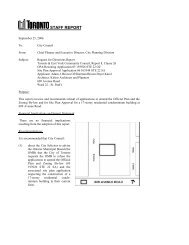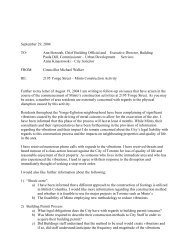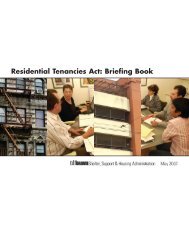Residential Tenancy Reform Consultation Paper
Residential Tenancy Reform Consultation Paper - Michael Walker
Residential Tenancy Reform Consultation Paper - Michael Walker
Create successful ePaper yourself
Turn your PDF publications into a flip-book with our unique Google optimized e-Paper software.
RESIDENTIAL TENANCY REFORM CONSULTATION PAPER<br />
Making landlords and tenants aware<br />
of their rights and responsibilities<br />
To ensure that tenants and landlords are aware of their<br />
rights and responsibilities, the government could<br />
require that landlords of multi-unit buildings post a document<br />
outlining these rights and responsibilities in a conspicuous<br />
place on the rental property.<br />
Background:<br />
Previous legislation required landlords to post a summary<br />
of specific sections of the law that described the rights<br />
and obligations of tenants and landlords. This requirement<br />
was limited to multi-unit buildings, and the document had<br />
to be posted in a common area. This requirement was difficult<br />
to enforce, and landlords needed to be aware of any<br />
amendments to any section so they could ensure the most<br />
recent version was posted. It was sometimes difficult for<br />
landlords to comply with this requirement because of vandalism.<br />
A requirement to post this type of document was not<br />
included in the Tenant Protection Act, 1997 (TPA).<br />
Questions for consideration:<br />
1. Should landlords be required to post a document<br />
that is easy to see in rental buildings, giving<br />
information about the rights and responsibilities<br />
of landlords and tenants?<br />
A. Yes. Require landlords to post information about<br />
the rights and responsibilities of tenants and landlords.<br />
This option means that the majority of tenants would have<br />
access to this information in their buildings.<br />
B. No. Do not require landlords to post information<br />
about rights and responsibilities of tenants and<br />
landlords.<br />
With this option, tenants would not have access to the<br />
information in their buildings. However, it is possible that<br />
many tenants would not read the document anyway, but<br />
could continue to access all necessary information through<br />
the Ontario Rental Housing Tribunal (the Tribunal).<br />
2. What should the text of the document be?<br />
A. A copy of the sections of the new legislation that<br />
describe the rights and responsibilities of tenants<br />
and landlords.<br />
With this option, landlords would be responsible for<br />
ensuring that they replace the excerpt with an updated<br />
version, should there be subsequent amendments to the<br />
section.<br />
This option would ensure that the relevant parts of the<br />
legislation are available in a readily accessible location.<br />
However, some tenants might find the legal nature of the<br />
text difficult to understand.<br />
B. A plain-language summary of the sections of the<br />
new legislation that describes the rights and<br />
responsibilities of tenants and landlords.<br />
With this option, the government would issue an official<br />
summary in clear language.<br />
This option would make the text more readable and userfriendly.<br />
The drawback of options A and B is that each would<br />
require a multiple-page document. This is likely too long<br />
to be effective in posted form.<br />
C. A brief explanation of how the Ontario Rental<br />
Housing Tribunal helps tenants and landlords, and<br />
contact information such as the phone number<br />
and website.<br />
This option would produce the shortest and simplest<br />
document. Tenants would still be made aware of how to<br />
access the information, and could contact the Tribunal for<br />
assistance with specific issues.<br />
24






